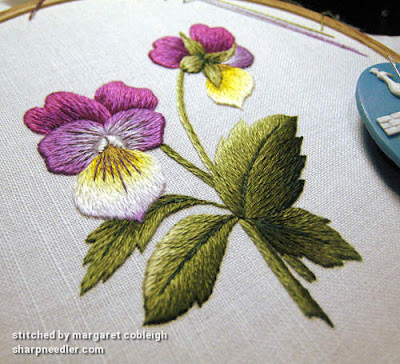As I'm nearing completion of the embroidered part of Wild Child, I'm contemplating what to work on next. I have two other large pieces to finish (Summer of Love Challenge and Antique Society Silk Violets), but I need to do some relaxing stitching for a bit. I think I'm going to find a small thread painting project in order to give my brain a rest.
One of my favourite sources for easy, but gratifying shaded embroidery projects is Trish Burr's book Needle Painting Embroidery: Fresh Ideas for Beginners. While it's a wonderful book for beginners, there's enough detail to interest more advanced needlepainters.
Several years ago, I embroidered Wild Pansy.
The pansies (or violas) are very easy to stitch and are not very big, so don't require a huge time commitment. This design uses Anchor cotton floss (with DMC equivalents listed), unlike most of the projects in the book which call for DMC. I like Anchor and DMC threads equally and I wish Anchor threads were easier to find here in the States.
Unfortunately, I don't have a lot of photos of this project. I was teaching an online class at the time and wanted something easy to work on in the background, so photos weren't a priority.
Here are the completed stems, leaves, and most of the main flower:
Even on a little piece like this, thread parking is useful.
I like this photo because the central leaf appears to be sticking up as if it is 3-D embroidery!
I have two favourite bits. One is the little blush of colour at the tip of the main flower's central petal. It's simply perfect and it's all due to Trish's colour choices.
The other is the turnover on the tiny sepal at the very top of the piece. The one little dark stitch that created the shadow in the middle of the turnover made it sing for me. I'm often struck by the little things in my embroidery that probably go unnoticed by anyone else viewing the work.
The completed violas:
So, what am I going to work on next? I'm not sure, but it might involve feathers.
Summer 2024: Google ended its email subscription service in 2021. I believe I've found a replacement, but haven't had time to test it. I have been stitching a little bit here and there and have some posts ready for when the email subscription is active again. Fingers crossed, I'll have time to rouse this blog out of its dormancy sometime this year.
30 April 2019
Subscribe to:
Post Comments
(
Atom
)






Just lovely! Thank you for sharing.
ReplyDeleteThank you and it's my pleasure to share!
DeleteI love embroidering These sweet violas ....their cheerful faces come in so many colours and variations that they always delight !
ReplyDeleteI agree. I never tire of embroidering pansies/violas.
DeleteThe colors in this piece are just so pretty. I always wanted to learn thread painting but find it so daunting. I'll have to bite the bullet one day and just practice.
ReplyDeleteThread painting isn't that difficult, but does require practice. Trish Burr's beginner book is a good place to start. Also, Tanja Berlin has some beginner kits and her instructions are *very* detailed.
DeleteAbsolutely gorgeous! I love viola flowers, and the complex shading in such a small space makes them look very nearly real :) An embroidered feather or a bird would be an interesting challenge, looking forward to seeing your work on whatever your next project will be!
ReplyDeleteThank you. This was (and is) very pretty and enjoyable to stitch.
DeleteI have recently bought that book. I have been too busy to try anything out of it yet. I just love your violas and their leaves.
ReplyDeleteIt's a nice book. If you're a beginner, be sure to start at the beginning and work your way through. The first few projects help you get your feet wet in the technique, so to speak, without being too complex.
DeleteHermoso sus diseños y colores.
ReplyDelete